Factors Influencing Consumer Behaviour in Tourism: A Detailed Report
VerifiedAdded on 2023/01/11
|13
|4159
|59
Report
AI Summary
This report analyzes consumer behavior within the tourism industry, focusing on factors that influence consumer attitudes and decision-making processes. The report begins by outlining various cultural, social, personal, and psychological factors impacting consumer behavior, using Trailfinders as a case study. It then explores how digital technology is reshaping consumer trends, such as destination promotion and service delivery. The report details the stages of the consumer decision-making journey, from need recognition to post-purchase evaluation, and maps the consumer's path to purchase for tourism services like accommodation. The importance for marketers to understand and map the path to purchase is emphasized, with a discussion on the impact on ROI and consumer information gathering. The report evaluates how marketers respond to the decision-making process, using examples from the tourism sector. It compares and contrasts the B2C and B2B decision-making processes, offering specific tourism examples. Finally, it examines market research approaches and how marketers influence different stages of the tourism decision-making process, providing insights into the complexities of the consumer experience.
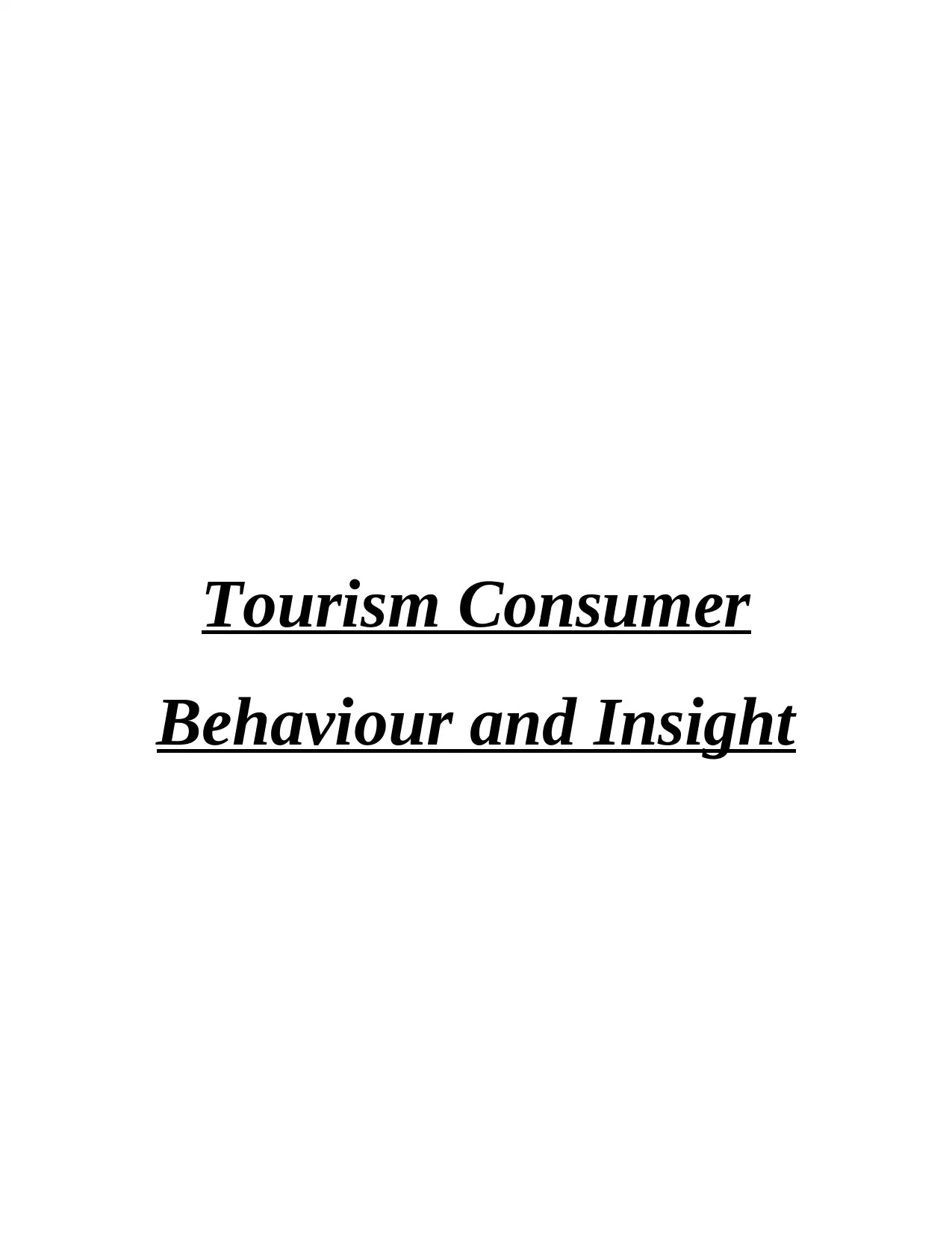
Tourism Consumer
Behaviour and Insight
Behaviour and Insight
Paraphrase This Document
Need a fresh take? Get an instant paraphrase of this document with our AI Paraphraser
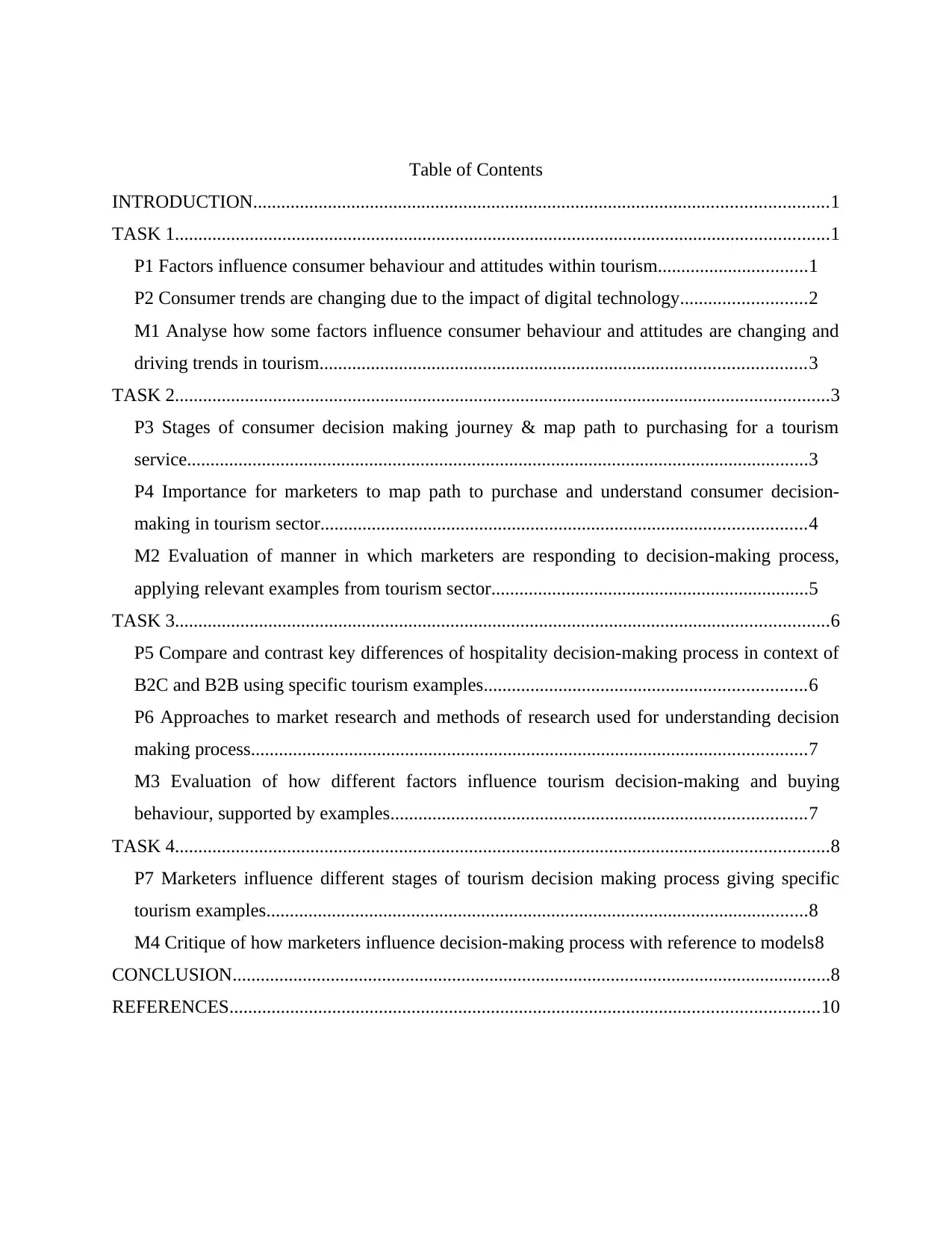
Table of Contents
INTRODUCTION...........................................................................................................................1
TASK 1............................................................................................................................................1
P1 Factors influence consumer behaviour and attitudes within tourism................................1
P2 Consumer trends are changing due to the impact of digital technology...........................2
M1 Analyse how some factors influence consumer behaviour and attitudes are changing and
driving trends in tourism........................................................................................................3
TASK 2............................................................................................................................................3
P3 Stages of consumer decision making journey & map path to purchasing for a tourism
service.....................................................................................................................................3
P4 Importance for marketers to map path to purchase and understand consumer decision-
making in tourism sector........................................................................................................4
M2 Evaluation of manner in which marketers are responding to decision-making process,
applying relevant examples from tourism sector....................................................................5
TASK 3............................................................................................................................................6
P5 Compare and contrast key differences of hospitality decision-making process in context of
B2C and B2B using specific tourism examples.....................................................................6
P6 Approaches to market research and methods of research used for understanding decision
making process.......................................................................................................................7
M3 Evaluation of how different factors influence tourism decision-making and buying
behaviour, supported by examples.........................................................................................7
TASK 4............................................................................................................................................8
P7 Marketers influence different stages of tourism decision making process giving specific
tourism examples....................................................................................................................8
M4 Critique of how marketers influence decision-making process with reference to models8
CONCLUSION................................................................................................................................8
REFERENCES..............................................................................................................................10
INTRODUCTION...........................................................................................................................1
TASK 1............................................................................................................................................1
P1 Factors influence consumer behaviour and attitudes within tourism................................1
P2 Consumer trends are changing due to the impact of digital technology...........................2
M1 Analyse how some factors influence consumer behaviour and attitudes are changing and
driving trends in tourism........................................................................................................3
TASK 2............................................................................................................................................3
P3 Stages of consumer decision making journey & map path to purchasing for a tourism
service.....................................................................................................................................3
P4 Importance for marketers to map path to purchase and understand consumer decision-
making in tourism sector........................................................................................................4
M2 Evaluation of manner in which marketers are responding to decision-making process,
applying relevant examples from tourism sector....................................................................5
TASK 3............................................................................................................................................6
P5 Compare and contrast key differences of hospitality decision-making process in context of
B2C and B2B using specific tourism examples.....................................................................6
P6 Approaches to market research and methods of research used for understanding decision
making process.......................................................................................................................7
M3 Evaluation of how different factors influence tourism decision-making and buying
behaviour, supported by examples.........................................................................................7
TASK 4............................................................................................................................................8
P7 Marketers influence different stages of tourism decision making process giving specific
tourism examples....................................................................................................................8
M4 Critique of how marketers influence decision-making process with reference to models8
CONCLUSION................................................................................................................................8
REFERENCES..............................................................................................................................10
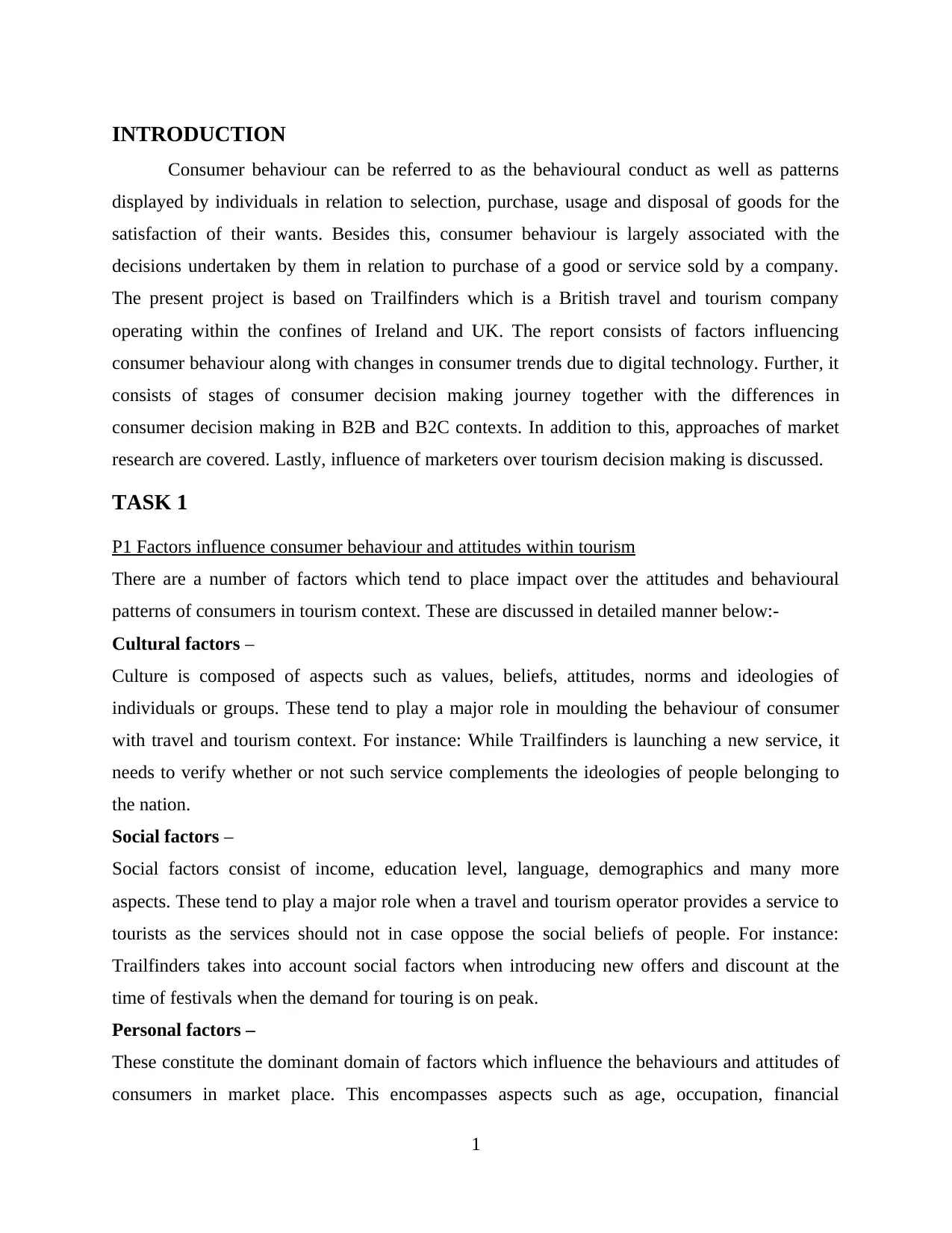
INTRODUCTION
Consumer behaviour can be referred to as the behavioural conduct as well as patterns
displayed by individuals in relation to selection, purchase, usage and disposal of goods for the
satisfaction of their wants. Besides this, consumer behaviour is largely associated with the
decisions undertaken by them in relation to purchase of a good or service sold by a company.
The present project is based on Trailfinders which is a British travel and tourism company
operating within the confines of Ireland and UK. The report consists of factors influencing
consumer behaviour along with changes in consumer trends due to digital technology. Further, it
consists of stages of consumer decision making journey together with the differences in
consumer decision making in B2B and B2C contexts. In addition to this, approaches of market
research are covered. Lastly, influence of marketers over tourism decision making is discussed.
TASK 1
P1 Factors influence consumer behaviour and attitudes within tourism
There are a number of factors which tend to place impact over the attitudes and behavioural
patterns of consumers in tourism context. These are discussed in detailed manner below:-
Cultural factors –
Culture is composed of aspects such as values, beliefs, attitudes, norms and ideologies of
individuals or groups. These tend to play a major role in moulding the behaviour of consumer
with travel and tourism context. For instance: While Trailfinders is launching a new service, it
needs to verify whether or not such service complements the ideologies of people belonging to
the nation.
Social factors –
Social factors consist of income, education level, language, demographics and many more
aspects. These tend to play a major role when a travel and tourism operator provides a service to
tourists as the services should not in case oppose the social beliefs of people. For instance:
Trailfinders takes into account social factors when introducing new offers and discount at the
time of festivals when the demand for touring is on peak.
Personal factors –
These constitute the dominant domain of factors which influence the behaviours and attitudes of
consumers in market place. This encompasses aspects such as age, occupation, financial
1
Consumer behaviour can be referred to as the behavioural conduct as well as patterns
displayed by individuals in relation to selection, purchase, usage and disposal of goods for the
satisfaction of their wants. Besides this, consumer behaviour is largely associated with the
decisions undertaken by them in relation to purchase of a good or service sold by a company.
The present project is based on Trailfinders which is a British travel and tourism company
operating within the confines of Ireland and UK. The report consists of factors influencing
consumer behaviour along with changes in consumer trends due to digital technology. Further, it
consists of stages of consumer decision making journey together with the differences in
consumer decision making in B2B and B2C contexts. In addition to this, approaches of market
research are covered. Lastly, influence of marketers over tourism decision making is discussed.
TASK 1
P1 Factors influence consumer behaviour and attitudes within tourism
There are a number of factors which tend to place impact over the attitudes and behavioural
patterns of consumers in tourism context. These are discussed in detailed manner below:-
Cultural factors –
Culture is composed of aspects such as values, beliefs, attitudes, norms and ideologies of
individuals or groups. These tend to play a major role in moulding the behaviour of consumer
with travel and tourism context. For instance: While Trailfinders is launching a new service, it
needs to verify whether or not such service complements the ideologies of people belonging to
the nation.
Social factors –
Social factors consist of income, education level, language, demographics and many more
aspects. These tend to play a major role when a travel and tourism operator provides a service to
tourists as the services should not in case oppose the social beliefs of people. For instance:
Trailfinders takes into account social factors when introducing new offers and discount at the
time of festivals when the demand for touring is on peak.
Personal factors –
These constitute the dominant domain of factors which influence the behaviours and attitudes of
consumers in market place. This encompasses aspects such as age, occupation, financial
1
⊘ This is a preview!⊘
Do you want full access?
Subscribe today to unlock all pages.

Trusted by 1+ million students worldwide
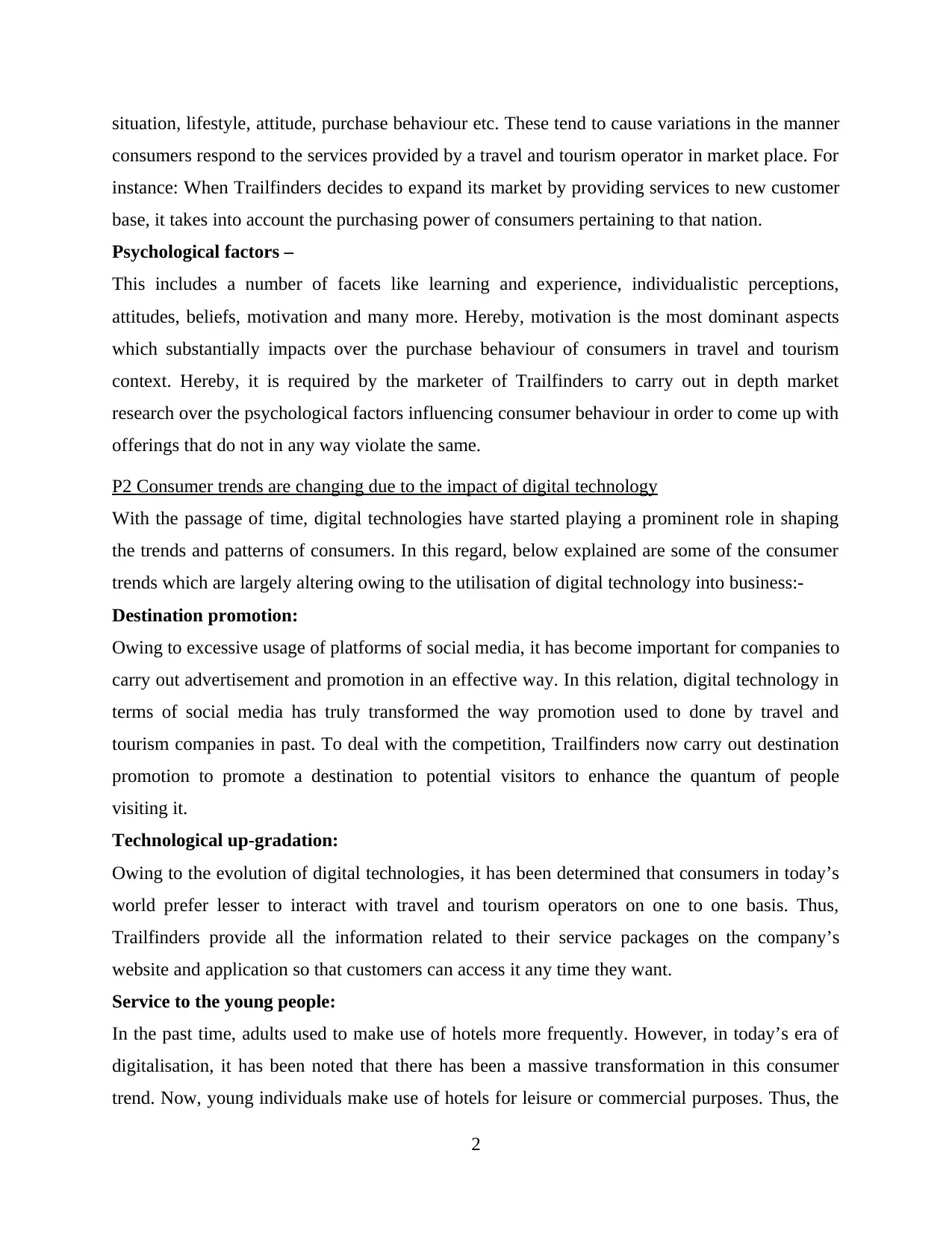
situation, lifestyle, attitude, purchase behaviour etc. These tend to cause variations in the manner
consumers respond to the services provided by a travel and tourism operator in market place. For
instance: When Trailfinders decides to expand its market by providing services to new customer
base, it takes into account the purchasing power of consumers pertaining to that nation.
Psychological factors –
This includes a number of facets like learning and experience, individualistic perceptions,
attitudes, beliefs, motivation and many more. Hereby, motivation is the most dominant aspects
which substantially impacts over the purchase behaviour of consumers in travel and tourism
context. Hereby, it is required by the marketer of Trailfinders to carry out in depth market
research over the psychological factors influencing consumer behaviour in order to come up with
offerings that do not in any way violate the same.
P2 Consumer trends are changing due to the impact of digital technology
With the passage of time, digital technologies have started playing a prominent role in shaping
the trends and patterns of consumers. In this regard, below explained are some of the consumer
trends which are largely altering owing to the utilisation of digital technology into business:-
Destination promotion:
Owing to excessive usage of platforms of social media, it has become important for companies to
carry out advertisement and promotion in an effective way. In this relation, digital technology in
terms of social media has truly transformed the way promotion used to done by travel and
tourism companies in past. To deal with the competition, Trailfinders now carry out destination
promotion to promote a destination to potential visitors to enhance the quantum of people
visiting it.
Technological up-gradation:
Owing to the evolution of digital technologies, it has been determined that consumers in today’s
world prefer lesser to interact with travel and tourism operators on one to one basis. Thus,
Trailfinders provide all the information related to their service packages on the company’s
website and application so that customers can access it any time they want.
Service to the young people:
In the past time, adults used to make use of hotels more frequently. However, in today’s era of
digitalisation, it has been noted that there has been a massive transformation in this consumer
trend. Now, young individuals make use of hotels for leisure or commercial purposes. Thus, the
2
consumers respond to the services provided by a travel and tourism operator in market place. For
instance: When Trailfinders decides to expand its market by providing services to new customer
base, it takes into account the purchasing power of consumers pertaining to that nation.
Psychological factors –
This includes a number of facets like learning and experience, individualistic perceptions,
attitudes, beliefs, motivation and many more. Hereby, motivation is the most dominant aspects
which substantially impacts over the purchase behaviour of consumers in travel and tourism
context. Hereby, it is required by the marketer of Trailfinders to carry out in depth market
research over the psychological factors influencing consumer behaviour in order to come up with
offerings that do not in any way violate the same.
P2 Consumer trends are changing due to the impact of digital technology
With the passage of time, digital technologies have started playing a prominent role in shaping
the trends and patterns of consumers. In this regard, below explained are some of the consumer
trends which are largely altering owing to the utilisation of digital technology into business:-
Destination promotion:
Owing to excessive usage of platforms of social media, it has become important for companies to
carry out advertisement and promotion in an effective way. In this relation, digital technology in
terms of social media has truly transformed the way promotion used to done by travel and
tourism companies in past. To deal with the competition, Trailfinders now carry out destination
promotion to promote a destination to potential visitors to enhance the quantum of people
visiting it.
Technological up-gradation:
Owing to the evolution of digital technologies, it has been determined that consumers in today’s
world prefer lesser to interact with travel and tourism operators on one to one basis. Thus,
Trailfinders provide all the information related to their service packages on the company’s
website and application so that customers can access it any time they want.
Service to the young people:
In the past time, adults used to make use of hotels more frequently. However, in today’s era of
digitalisation, it has been noted that there has been a massive transformation in this consumer
trend. Now, young individuals make use of hotels for leisure or commercial purposes. Thus, the
2
Paraphrase This Document
Need a fresh take? Get an instant paraphrase of this document with our AI Paraphraser
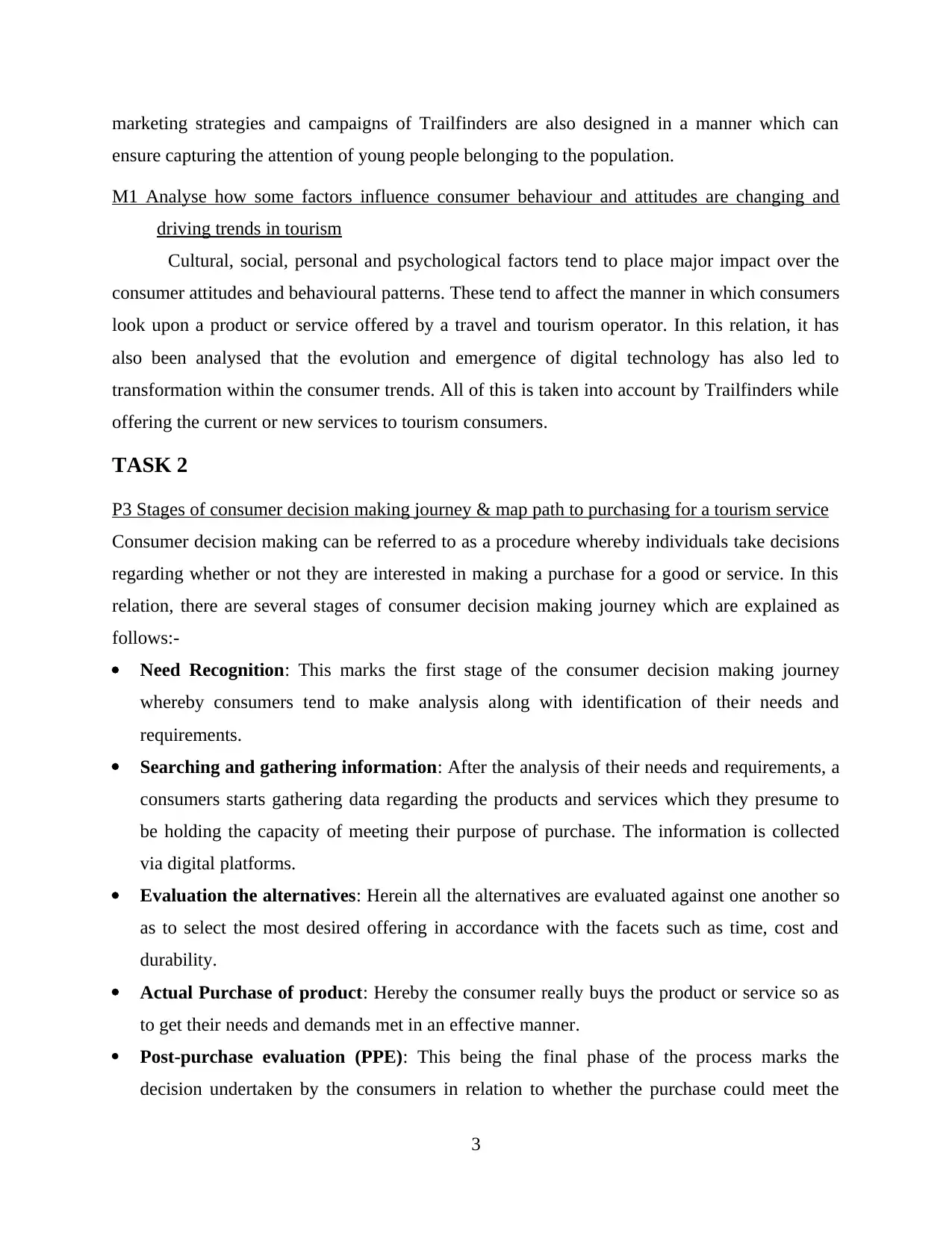
marketing strategies and campaigns of Trailfinders are also designed in a manner which can
ensure capturing the attention of young people belonging to the population.
M1 Analyse how some factors influence consumer behaviour and attitudes are changing and
driving trends in tourism
Cultural, social, personal and psychological factors tend to place major impact over the
consumer attitudes and behavioural patterns. These tend to affect the manner in which consumers
look upon a product or service offered by a travel and tourism operator. In this relation, it has
also been analysed that the evolution and emergence of digital technology has also led to
transformation within the consumer trends. All of this is taken into account by Trailfinders while
offering the current or new services to tourism consumers.
TASK 2
P3 Stages of consumer decision making journey & map path to purchasing for a tourism service
Consumer decision making can be referred to as a procedure whereby individuals take decisions
regarding whether or not they are interested in making a purchase for a good or service. In this
relation, there are several stages of consumer decision making journey which are explained as
follows:-
Need Recognition: This marks the first stage of the consumer decision making journey
whereby consumers tend to make analysis along with identification of their needs and
requirements.
Searching and gathering information: After the analysis of their needs and requirements, a
consumers starts gathering data regarding the products and services which they presume to
be holding the capacity of meeting their purpose of purchase. The information is collected
via digital platforms.
Evaluation the alternatives: Herein all the alternatives are evaluated against one another so
as to select the most desired offering in accordance with the facets such as time, cost and
durability.
Actual Purchase of product: Hereby the consumer really buys the product or service so as
to get their needs and demands met in an effective manner.
Post-purchase evaluation (PPE): This being the final phase of the process marks the
decision undertaken by the consumers in relation to whether the purchase could meet the
3
ensure capturing the attention of young people belonging to the population.
M1 Analyse how some factors influence consumer behaviour and attitudes are changing and
driving trends in tourism
Cultural, social, personal and psychological factors tend to place major impact over the
consumer attitudes and behavioural patterns. These tend to affect the manner in which consumers
look upon a product or service offered by a travel and tourism operator. In this relation, it has
also been analysed that the evolution and emergence of digital technology has also led to
transformation within the consumer trends. All of this is taken into account by Trailfinders while
offering the current or new services to tourism consumers.
TASK 2
P3 Stages of consumer decision making journey & map path to purchasing for a tourism service
Consumer decision making can be referred to as a procedure whereby individuals take decisions
regarding whether or not they are interested in making a purchase for a good or service. In this
relation, there are several stages of consumer decision making journey which are explained as
follows:-
Need Recognition: This marks the first stage of the consumer decision making journey
whereby consumers tend to make analysis along with identification of their needs and
requirements.
Searching and gathering information: After the analysis of their needs and requirements, a
consumers starts gathering data regarding the products and services which they presume to
be holding the capacity of meeting their purpose of purchase. The information is collected
via digital platforms.
Evaluation the alternatives: Herein all the alternatives are evaluated against one another so
as to select the most desired offering in accordance with the facets such as time, cost and
durability.
Actual Purchase of product: Hereby the consumer really buys the product or service so as
to get their needs and demands met in an effective manner.
Post-purchase evaluation (PPE): This being the final phase of the process marks the
decision undertaken by the consumers in relation to whether the purchase could meet the
3
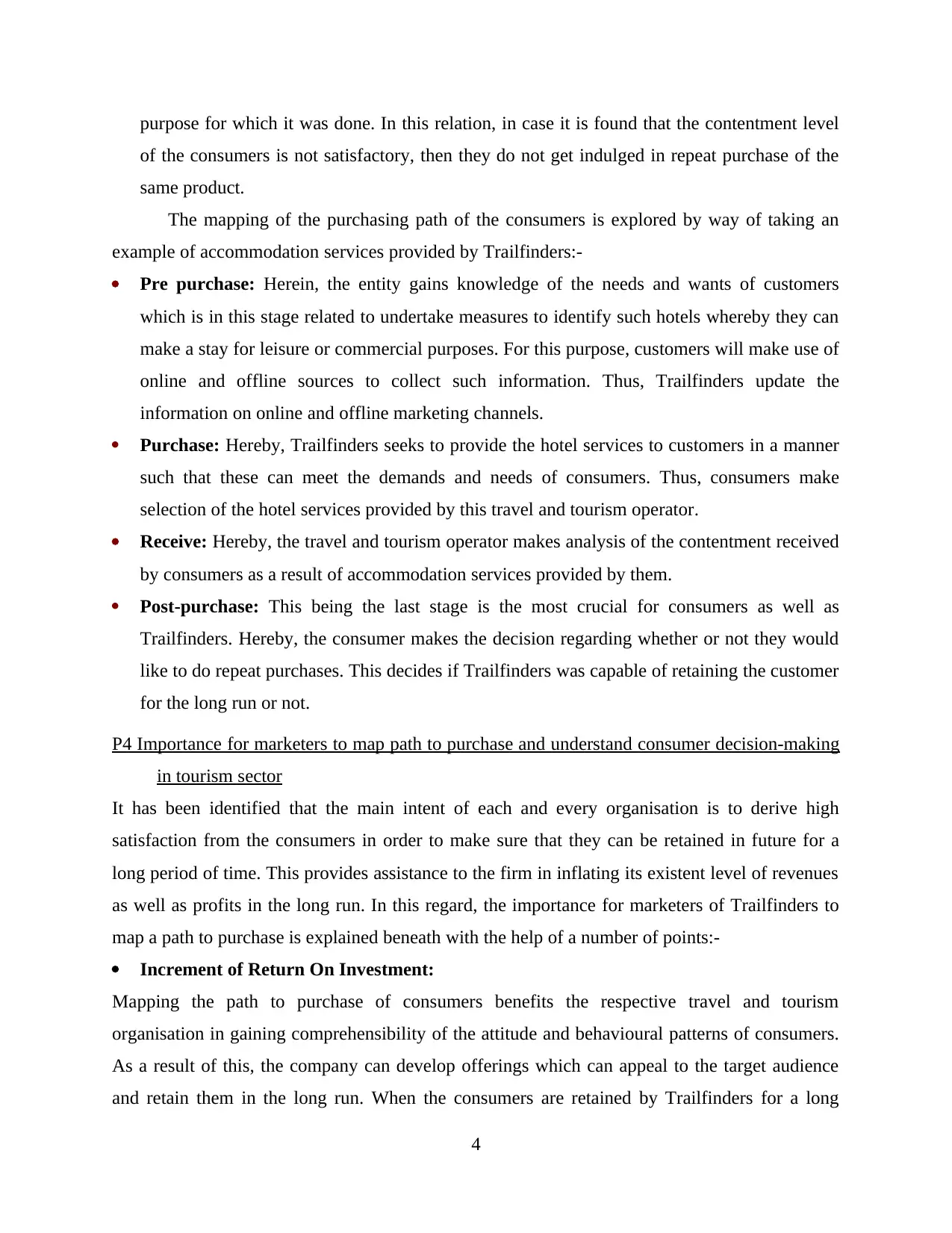
purpose for which it was done. In this relation, in case it is found that the contentment level
of the consumers is not satisfactory, then they do not get indulged in repeat purchase of the
same product.
The mapping of the purchasing path of the consumers is explored by way of taking an
example of accommodation services provided by Trailfinders:-
Pre purchase: Herein, the entity gains knowledge of the needs and wants of customers
which is in this stage related to undertake measures to identify such hotels whereby they can
make a stay for leisure or commercial purposes. For this purpose, customers will make use of
online and offline sources to collect such information. Thus, Trailfinders update the
information on online and offline marketing channels.
Purchase: Hereby, Trailfinders seeks to provide the hotel services to customers in a manner
such that these can meet the demands and needs of consumers. Thus, consumers make
selection of the hotel services provided by this travel and tourism operator.
Receive: Hereby, the travel and tourism operator makes analysis of the contentment received
by consumers as a result of accommodation services provided by them.
Post-purchase: This being the last stage is the most crucial for consumers as well as
Trailfinders. Hereby, the consumer makes the decision regarding whether or not they would
like to do repeat purchases. This decides if Trailfinders was capable of retaining the customer
for the long run or not.
P4 Importance for marketers to map path to purchase and understand consumer decision-making
in tourism sector
It has been identified that the main intent of each and every organisation is to derive high
satisfaction from the consumers in order to make sure that they can be retained in future for a
long period of time. This provides assistance to the firm in inflating its existent level of revenues
as well as profits in the long run. In this regard, the importance for marketers of Trailfinders to
map a path to purchase is explained beneath with the help of a number of points:-
Increment of Return On Investment:
Mapping the path to purchase of consumers benefits the respective travel and tourism
organisation in gaining comprehensibility of the attitude and behavioural patterns of consumers.
As a result of this, the company can develop offerings which can appeal to the target audience
and retain them in the long run. When the consumers are retained by Trailfinders for a long
4
of the consumers is not satisfactory, then they do not get indulged in repeat purchase of the
same product.
The mapping of the purchasing path of the consumers is explored by way of taking an
example of accommodation services provided by Trailfinders:-
Pre purchase: Herein, the entity gains knowledge of the needs and wants of customers
which is in this stage related to undertake measures to identify such hotels whereby they can
make a stay for leisure or commercial purposes. For this purpose, customers will make use of
online and offline sources to collect such information. Thus, Trailfinders update the
information on online and offline marketing channels.
Purchase: Hereby, Trailfinders seeks to provide the hotel services to customers in a manner
such that these can meet the demands and needs of consumers. Thus, consumers make
selection of the hotel services provided by this travel and tourism operator.
Receive: Hereby, the travel and tourism operator makes analysis of the contentment received
by consumers as a result of accommodation services provided by them.
Post-purchase: This being the last stage is the most crucial for consumers as well as
Trailfinders. Hereby, the consumer makes the decision regarding whether or not they would
like to do repeat purchases. This decides if Trailfinders was capable of retaining the customer
for the long run or not.
P4 Importance for marketers to map path to purchase and understand consumer decision-making
in tourism sector
It has been identified that the main intent of each and every organisation is to derive high
satisfaction from the consumers in order to make sure that they can be retained in future for a
long period of time. This provides assistance to the firm in inflating its existent level of revenues
as well as profits in the long run. In this regard, the importance for marketers of Trailfinders to
map a path to purchase is explained beneath with the help of a number of points:-
Increment of Return On Investment:
Mapping the path to purchase of consumers benefits the respective travel and tourism
organisation in gaining comprehensibility of the attitude and behavioural patterns of consumers.
As a result of this, the company can develop offerings which can appeal to the target audience
and retain them in the long run. When the consumers are retained by Trailfinders for a long
4
⊘ This is a preview!⊘
Do you want full access?
Subscribe today to unlock all pages.

Trusted by 1+ million students worldwide
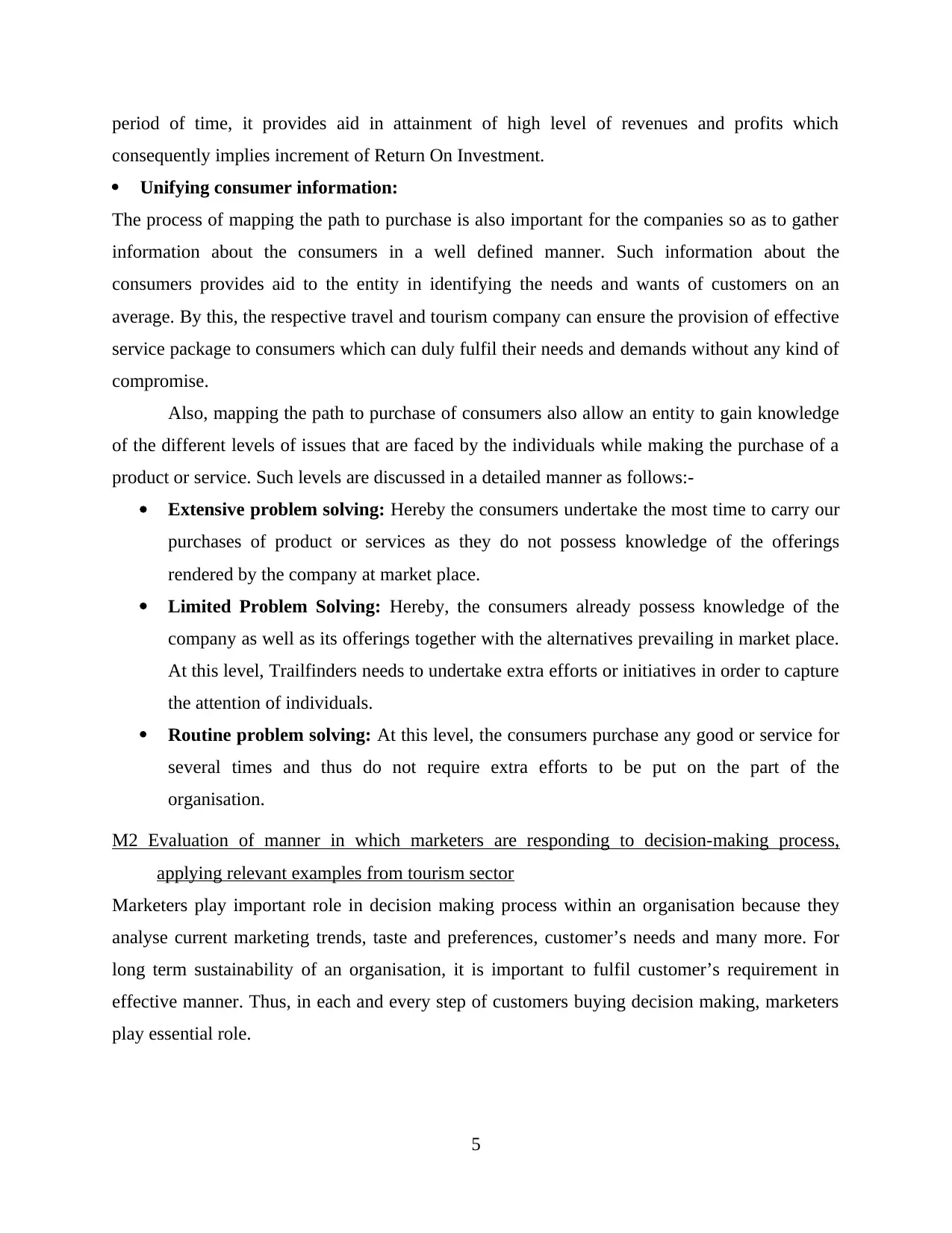
period of time, it provides aid in attainment of high level of revenues and profits which
consequently implies increment of Return On Investment.
Unifying consumer information:
The process of mapping the path to purchase is also important for the companies so as to gather
information about the consumers in a well defined manner. Such information about the
consumers provides aid to the entity in identifying the needs and wants of customers on an
average. By this, the respective travel and tourism company can ensure the provision of effective
service package to consumers which can duly fulfil their needs and demands without any kind of
compromise.
Also, mapping the path to purchase of consumers also allow an entity to gain knowledge
of the different levels of issues that are faced by the individuals while making the purchase of a
product or service. Such levels are discussed in a detailed manner as follows:-
Extensive problem solving: Hereby the consumers undertake the most time to carry our
purchases of product or services as they do not possess knowledge of the offerings
rendered by the company at market place.
Limited Problem Solving: Hereby, the consumers already possess knowledge of the
company as well as its offerings together with the alternatives prevailing in market place.
At this level, Trailfinders needs to undertake extra efforts or initiatives in order to capture
the attention of individuals.
Routine problem solving: At this level, the consumers purchase any good or service for
several times and thus do not require extra efforts to be put on the part of the
organisation.
M2 Evaluation of manner in which marketers are responding to decision-making process,
applying relevant examples from tourism sector
Marketers play important role in decision making process within an organisation because they
analyse current marketing trends, taste and preferences, customer’s needs and many more. For
long term sustainability of an organisation, it is important to fulfil customer’s requirement in
effective manner. Thus, in each and every step of customers buying decision making, marketers
play essential role.
5
consequently implies increment of Return On Investment.
Unifying consumer information:
The process of mapping the path to purchase is also important for the companies so as to gather
information about the consumers in a well defined manner. Such information about the
consumers provides aid to the entity in identifying the needs and wants of customers on an
average. By this, the respective travel and tourism company can ensure the provision of effective
service package to consumers which can duly fulfil their needs and demands without any kind of
compromise.
Also, mapping the path to purchase of consumers also allow an entity to gain knowledge
of the different levels of issues that are faced by the individuals while making the purchase of a
product or service. Such levels are discussed in a detailed manner as follows:-
Extensive problem solving: Hereby the consumers undertake the most time to carry our
purchases of product or services as they do not possess knowledge of the offerings
rendered by the company at market place.
Limited Problem Solving: Hereby, the consumers already possess knowledge of the
company as well as its offerings together with the alternatives prevailing in market place.
At this level, Trailfinders needs to undertake extra efforts or initiatives in order to capture
the attention of individuals.
Routine problem solving: At this level, the consumers purchase any good or service for
several times and thus do not require extra efforts to be put on the part of the
organisation.
M2 Evaluation of manner in which marketers are responding to decision-making process,
applying relevant examples from tourism sector
Marketers play important role in decision making process within an organisation because they
analyse current marketing trends, taste and preferences, customer’s needs and many more. For
long term sustainability of an organisation, it is important to fulfil customer’s requirement in
effective manner. Thus, in each and every step of customers buying decision making, marketers
play essential role.
5
Paraphrase This Document
Need a fresh take? Get an instant paraphrase of this document with our AI Paraphraser
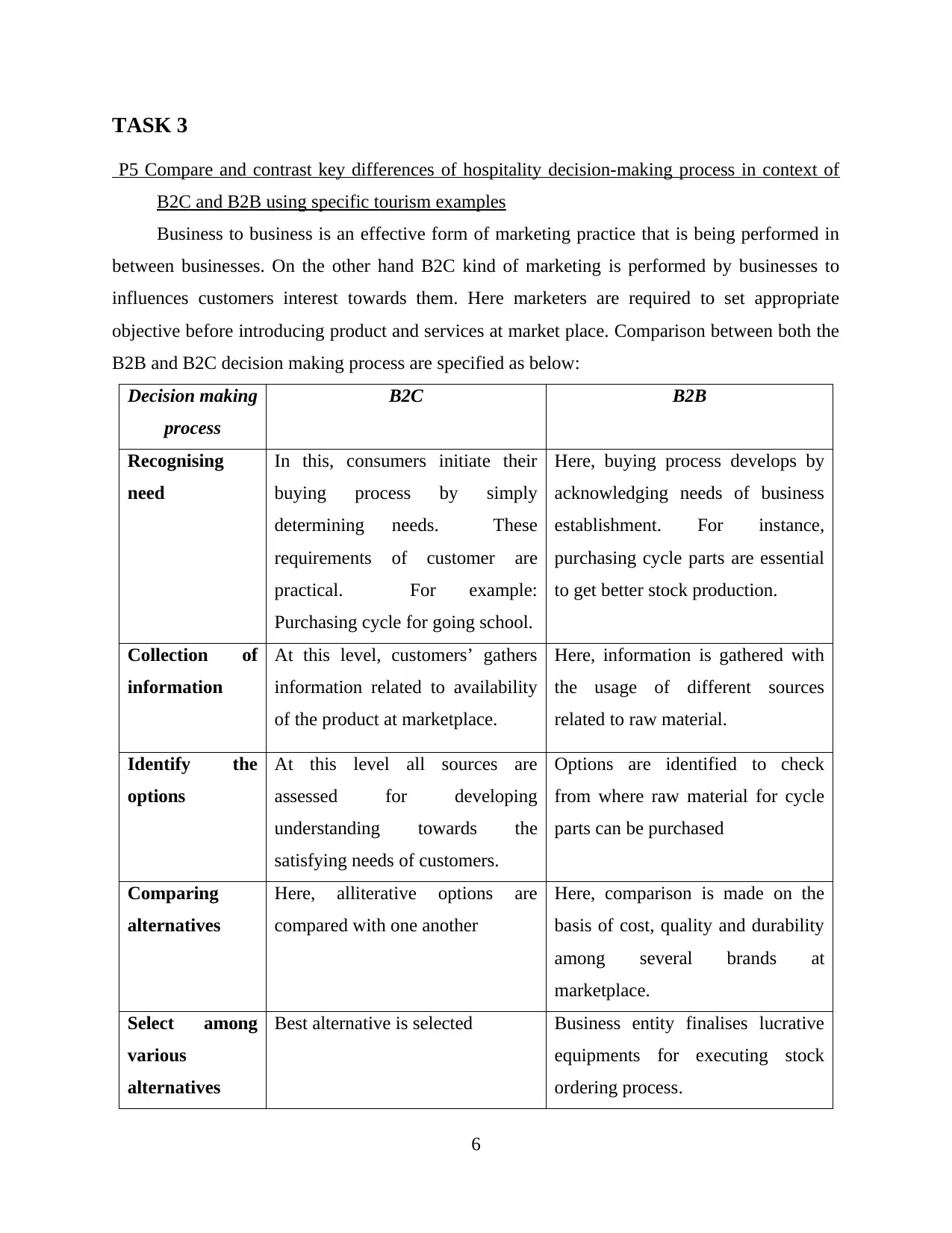
TASK 3
P5 Compare and contrast key differences of hospitality decision-making process in context of
B2C and B2B using specific tourism examples
Business to business is an effective form of marketing practice that is being performed in
between businesses. On the other hand B2C kind of marketing is performed by businesses to
influences customers interest towards them. Here marketers are required to set appropriate
objective before introducing product and services at market place. Comparison between both the
B2B and B2C decision making process are specified as below:
Decision making
process
B2C B2B
Recognising
need
In this, consumers initiate their
buying process by simply
determining needs. These
requirements of customer are
practical. For example:
Purchasing cycle for going school.
Here, buying process develops by
acknowledging needs of business
establishment. For instance,
purchasing cycle parts are essential
to get better stock production.
Collection of
information
At this level, customers’ gathers
information related to availability
of the product at marketplace.
Here, information is gathered with
the usage of different sources
related to raw material.
Identify the
options
At this level all sources are
assessed for developing
understanding towards the
satisfying needs of customers.
Options are identified to check
from where raw material for cycle
parts can be purchased
Comparing
alternatives
Here, alliterative options are
compared with one another
Here, comparison is made on the
basis of cost, quality and durability
among several brands at
marketplace.
Select among
various
alternatives
Best alternative is selected Business entity finalises lucrative
equipments for executing stock
ordering process.
6
P5 Compare and contrast key differences of hospitality decision-making process in context of
B2C and B2B using specific tourism examples
Business to business is an effective form of marketing practice that is being performed in
between businesses. On the other hand B2C kind of marketing is performed by businesses to
influences customers interest towards them. Here marketers are required to set appropriate
objective before introducing product and services at market place. Comparison between both the
B2B and B2C decision making process are specified as below:
Decision making
process
B2C B2B
Recognising
need
In this, consumers initiate their
buying process by simply
determining needs. These
requirements of customer are
practical. For example:
Purchasing cycle for going school.
Here, buying process develops by
acknowledging needs of business
establishment. For instance,
purchasing cycle parts are essential
to get better stock production.
Collection of
information
At this level, customers’ gathers
information related to availability
of the product at marketplace.
Here, information is gathered with
the usage of different sources
related to raw material.
Identify the
options
At this level all sources are
assessed for developing
understanding towards the
satisfying needs of customers.
Options are identified to check
from where raw material for cycle
parts can be purchased
Comparing
alternatives
Here, alliterative options are
compared with one another
Here, comparison is made on the
basis of cost, quality and durability
among several brands at
marketplace.
Select among
various
alternatives
Best alternative is selected Business entity finalises lucrative
equipments for executing stock
ordering process.
6
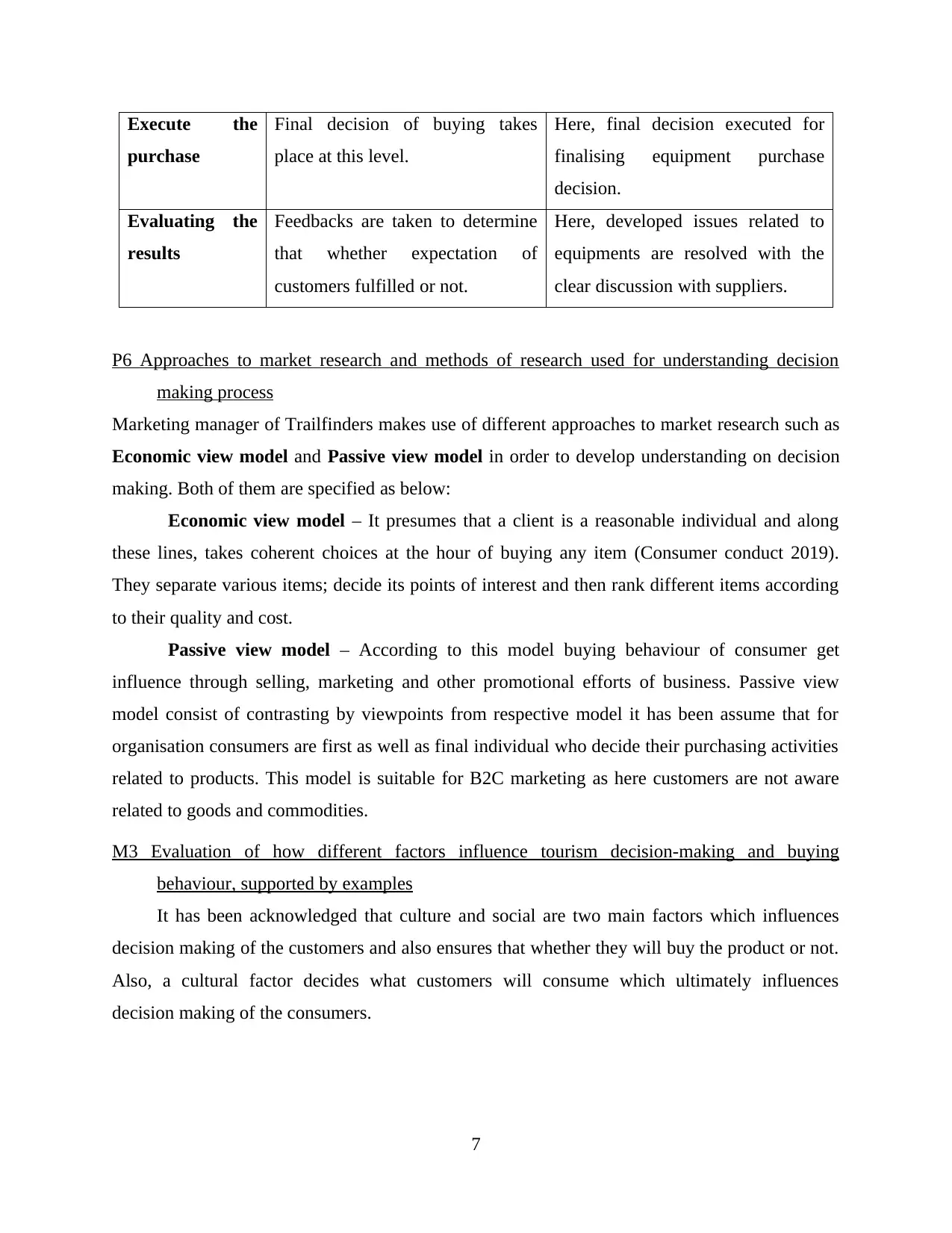
Execute the
purchase
Final decision of buying takes
place at this level.
Here, final decision executed for
finalising equipment purchase
decision.
Evaluating the
results
Feedbacks are taken to determine
that whether expectation of
customers fulfilled or not.
Here, developed issues related to
equipments are resolved with the
clear discussion with suppliers.
P6 Approaches to market research and methods of research used for understanding decision
making process
Marketing manager of Trailfinders makes use of different approaches to market research such as
Economic view model and Passive view model in order to develop understanding on decision
making. Both of them are specified as below:
Economic view model – It presumes that a client is a reasonable individual and along
these lines, takes coherent choices at the hour of buying any item (Consumer conduct 2019).
They separate various items; decide its points of interest and then rank different items according
to their quality and cost.
Passive view model – According to this model buying behaviour of consumer get
influence through selling, marketing and other promotional efforts of business. Passive view
model consist of contrasting by viewpoints from respective model it has been assume that for
organisation consumers are first as well as final individual who decide their purchasing activities
related to products. This model is suitable for B2C marketing as here customers are not aware
related to goods and commodities.
M3 Evaluation of how different factors influence tourism decision-making and buying
behaviour, supported by examples
It has been acknowledged that culture and social are two main factors which influences
decision making of the customers and also ensures that whether they will buy the product or not.
Also, a cultural factor decides what customers will consume which ultimately influences
decision making of the consumers.
7
purchase
Final decision of buying takes
place at this level.
Here, final decision executed for
finalising equipment purchase
decision.
Evaluating the
results
Feedbacks are taken to determine
that whether expectation of
customers fulfilled or not.
Here, developed issues related to
equipments are resolved with the
clear discussion with suppliers.
P6 Approaches to market research and methods of research used for understanding decision
making process
Marketing manager of Trailfinders makes use of different approaches to market research such as
Economic view model and Passive view model in order to develop understanding on decision
making. Both of them are specified as below:
Economic view model – It presumes that a client is a reasonable individual and along
these lines, takes coherent choices at the hour of buying any item (Consumer conduct 2019).
They separate various items; decide its points of interest and then rank different items according
to their quality and cost.
Passive view model – According to this model buying behaviour of consumer get
influence through selling, marketing and other promotional efforts of business. Passive view
model consist of contrasting by viewpoints from respective model it has been assume that for
organisation consumers are first as well as final individual who decide their purchasing activities
related to products. This model is suitable for B2C marketing as here customers are not aware
related to goods and commodities.
M3 Evaluation of how different factors influence tourism decision-making and buying
behaviour, supported by examples
It has been acknowledged that culture and social are two main factors which influences
decision making of the customers and also ensures that whether they will buy the product or not.
Also, a cultural factor decides what customers will consume which ultimately influences
decision making of the consumers.
7
⊘ This is a preview!⊘
Do you want full access?
Subscribe today to unlock all pages.

Trusted by 1+ million students worldwide
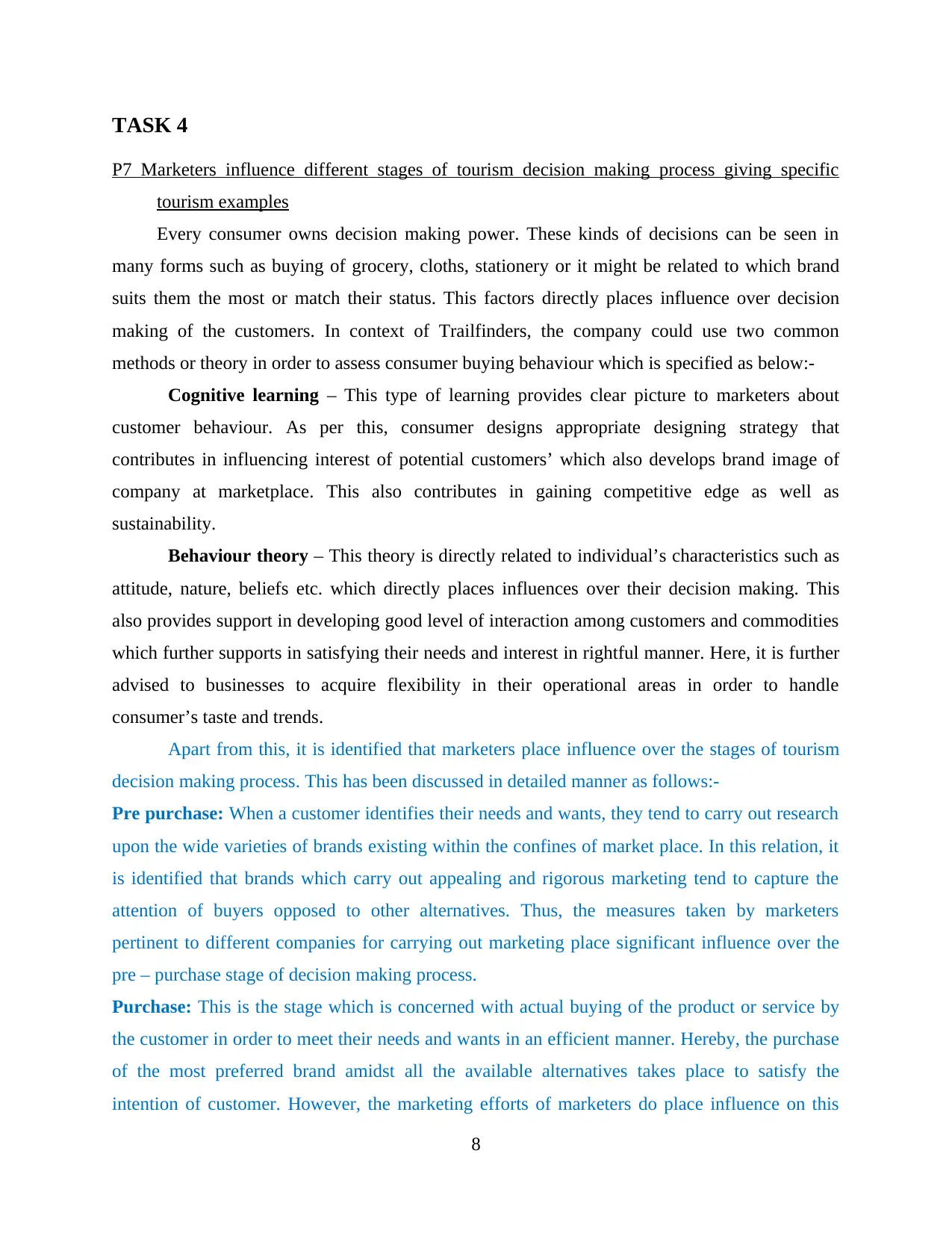
TASK 4
P7 Marketers influence different stages of tourism decision making process giving specific
tourism examples
Every consumer owns decision making power. These kinds of decisions can be seen in
many forms such as buying of grocery, cloths, stationery or it might be related to which brand
suits them the most or match their status. This factors directly places influence over decision
making of the customers. In context of Trailfinders, the company could use two common
methods or theory in order to assess consumer buying behaviour which is specified as below:-
Cognitive learning – This type of learning provides clear picture to marketers about
customer behaviour. As per this, consumer designs appropriate designing strategy that
contributes in influencing interest of potential customers’ which also develops brand image of
company at marketplace. This also contributes in gaining competitive edge as well as
sustainability.
Behaviour theory – This theory is directly related to individual’s characteristics such as
attitude, nature, beliefs etc. which directly places influences over their decision making. This
also provides support in developing good level of interaction among customers and commodities
which further supports in satisfying their needs and interest in rightful manner. Here, it is further
advised to businesses to acquire flexibility in their operational areas in order to handle
consumer’s taste and trends.
Apart from this, it is identified that marketers place influence over the stages of tourism
decision making process. This has been discussed in detailed manner as follows:-
Pre purchase: When a customer identifies their needs and wants, they tend to carry out research
upon the wide varieties of brands existing within the confines of market place. In this relation, it
is identified that brands which carry out appealing and rigorous marketing tend to capture the
attention of buyers opposed to other alternatives. Thus, the measures taken by marketers
pertinent to different companies for carrying out marketing place significant influence over the
pre – purchase stage of decision making process.
Purchase: This is the stage which is concerned with actual buying of the product or service by
the customer in order to meet their needs and wants in an efficient manner. Hereby, the purchase
of the most preferred brand amidst all the available alternatives takes place to satisfy the
intention of customer. However, the marketing efforts of marketers do place influence on this
8
P7 Marketers influence different stages of tourism decision making process giving specific
tourism examples
Every consumer owns decision making power. These kinds of decisions can be seen in
many forms such as buying of grocery, cloths, stationery or it might be related to which brand
suits them the most or match their status. This factors directly places influence over decision
making of the customers. In context of Trailfinders, the company could use two common
methods or theory in order to assess consumer buying behaviour which is specified as below:-
Cognitive learning – This type of learning provides clear picture to marketers about
customer behaviour. As per this, consumer designs appropriate designing strategy that
contributes in influencing interest of potential customers’ which also develops brand image of
company at marketplace. This also contributes in gaining competitive edge as well as
sustainability.
Behaviour theory – This theory is directly related to individual’s characteristics such as
attitude, nature, beliefs etc. which directly places influences over their decision making. This
also provides support in developing good level of interaction among customers and commodities
which further supports in satisfying their needs and interest in rightful manner. Here, it is further
advised to businesses to acquire flexibility in their operational areas in order to handle
consumer’s taste and trends.
Apart from this, it is identified that marketers place influence over the stages of tourism
decision making process. This has been discussed in detailed manner as follows:-
Pre purchase: When a customer identifies their needs and wants, they tend to carry out research
upon the wide varieties of brands existing within the confines of market place. In this relation, it
is identified that brands which carry out appealing and rigorous marketing tend to capture the
attention of buyers opposed to other alternatives. Thus, the measures taken by marketers
pertinent to different companies for carrying out marketing place significant influence over the
pre – purchase stage of decision making process.
Purchase: This is the stage which is concerned with actual buying of the product or service by
the customer in order to meet their needs and wants in an efficient manner. Hereby, the purchase
of the most preferred brand amidst all the available alternatives takes place to satisfy the
intention of customer. However, the marketing efforts of marketers do place influence on this
8
Paraphrase This Document
Need a fresh take? Get an instant paraphrase of this document with our AI Paraphraser
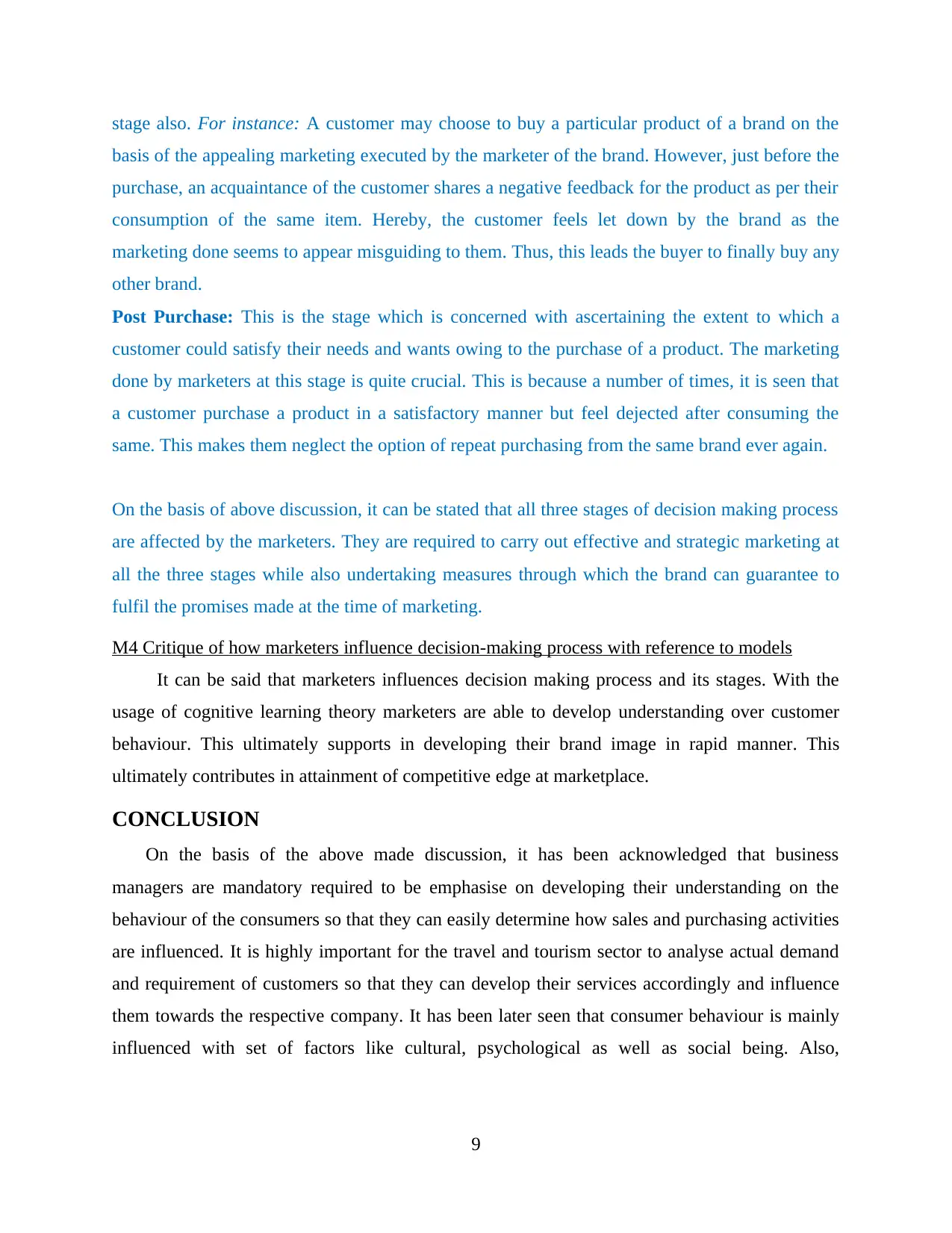
stage also. For instance: A customer may choose to buy a particular product of a brand on the
basis of the appealing marketing executed by the marketer of the brand. However, just before the
purchase, an acquaintance of the customer shares a negative feedback for the product as per their
consumption of the same item. Hereby, the customer feels let down by the brand as the
marketing done seems to appear misguiding to them. Thus, this leads the buyer to finally buy any
other brand.
Post Purchase: This is the stage which is concerned with ascertaining the extent to which a
customer could satisfy their needs and wants owing to the purchase of a product. The marketing
done by marketers at this stage is quite crucial. This is because a number of times, it is seen that
a customer purchase a product in a satisfactory manner but feel dejected after consuming the
same. This makes them neglect the option of repeat purchasing from the same brand ever again.
On the basis of above discussion, it can be stated that all three stages of decision making process
are affected by the marketers. They are required to carry out effective and strategic marketing at
all the three stages while also undertaking measures through which the brand can guarantee to
fulfil the promises made at the time of marketing.
M4 Critique of how marketers influence decision-making process with reference to models
It can be said that marketers influences decision making process and its stages. With the
usage of cognitive learning theory marketers are able to develop understanding over customer
behaviour. This ultimately supports in developing their brand image in rapid manner. This
ultimately contributes in attainment of competitive edge at marketplace.
CONCLUSION
On the basis of the above made discussion, it has been acknowledged that business
managers are mandatory required to be emphasise on developing their understanding on the
behaviour of the consumers so that they can easily determine how sales and purchasing activities
are influenced. It is highly important for the travel and tourism sector to analyse actual demand
and requirement of customers so that they can develop their services accordingly and influence
them towards the respective company. It has been later seen that consumer behaviour is mainly
influenced with set of factors like cultural, psychological as well as social being. Also,
9
basis of the appealing marketing executed by the marketer of the brand. However, just before the
purchase, an acquaintance of the customer shares a negative feedback for the product as per their
consumption of the same item. Hereby, the customer feels let down by the brand as the
marketing done seems to appear misguiding to them. Thus, this leads the buyer to finally buy any
other brand.
Post Purchase: This is the stage which is concerned with ascertaining the extent to which a
customer could satisfy their needs and wants owing to the purchase of a product. The marketing
done by marketers at this stage is quite crucial. This is because a number of times, it is seen that
a customer purchase a product in a satisfactory manner but feel dejected after consuming the
same. This makes them neglect the option of repeat purchasing from the same brand ever again.
On the basis of above discussion, it can be stated that all three stages of decision making process
are affected by the marketers. They are required to carry out effective and strategic marketing at
all the three stages while also undertaking measures through which the brand can guarantee to
fulfil the promises made at the time of marketing.
M4 Critique of how marketers influence decision-making process with reference to models
It can be said that marketers influences decision making process and its stages. With the
usage of cognitive learning theory marketers are able to develop understanding over customer
behaviour. This ultimately supports in developing their brand image in rapid manner. This
ultimately contributes in attainment of competitive edge at marketplace.
CONCLUSION
On the basis of the above made discussion, it has been acknowledged that business
managers are mandatory required to be emphasise on developing their understanding on the
behaviour of the consumers so that they can easily determine how sales and purchasing activities
are influenced. It is highly important for the travel and tourism sector to analyse actual demand
and requirement of customers so that they can develop their services accordingly and influence
them towards the respective company. It has been later seen that consumer behaviour is mainly
influenced with set of factors like cultural, psychological as well as social being. Also,
9

businesses must emphasise on making use of latest technology for attracting customers at
extensive level.
10
extensive level.
10
⊘ This is a preview!⊘
Do you want full access?
Subscribe today to unlock all pages.

Trusted by 1+ million students worldwide
1 out of 13
Related Documents
Your All-in-One AI-Powered Toolkit for Academic Success.
+13062052269
info@desklib.com
Available 24*7 on WhatsApp / Email
![[object Object]](/_next/static/media/star-bottom.7253800d.svg)
Unlock your academic potential
Copyright © 2020–2025 A2Z Services. All Rights Reserved. Developed and managed by ZUCOL.





